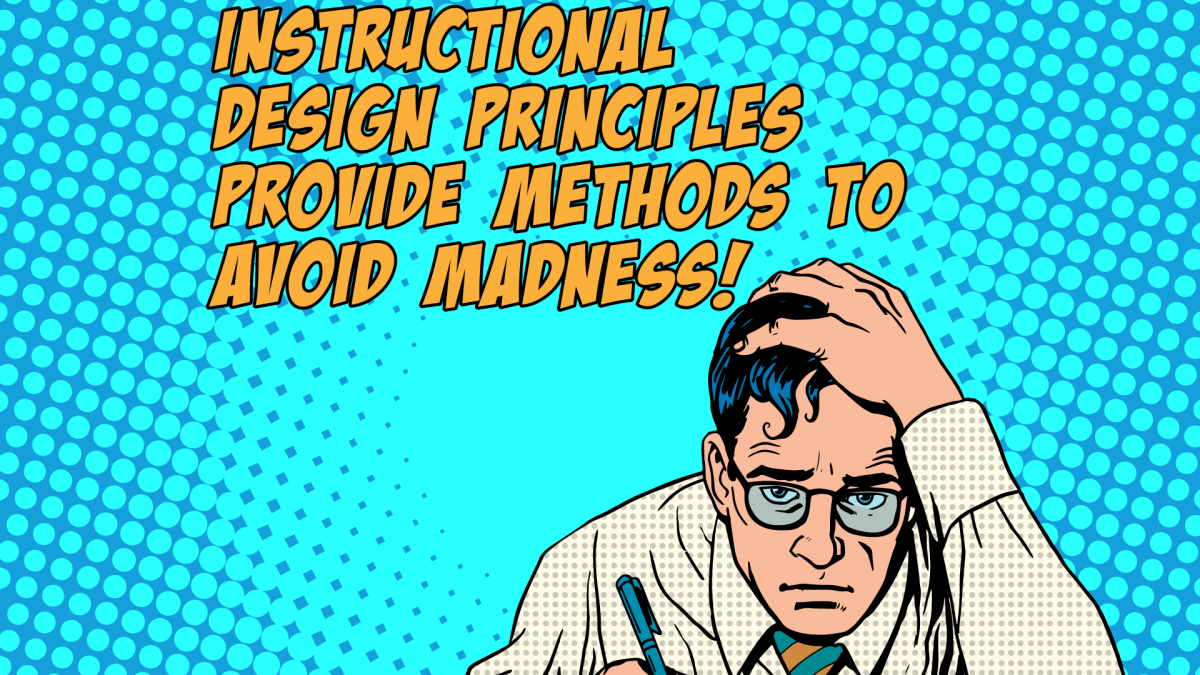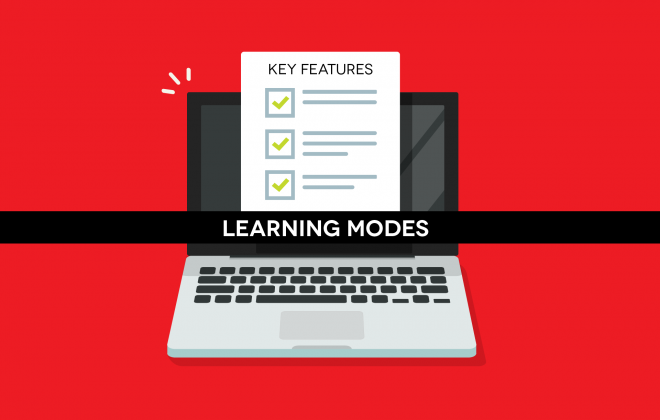
Instructional Design Principles Provide Methods to Avoid Madness
“I have no idea where to begin!”
How many times have you sat in front of a blank computer screen and pondered this thought? It is your job to write electronic learning (or eLearning) courses for students that you do not know personally and whom you will most likely never meet. Is it possible to come up with an online learning process that can work for everyone?
“Wow, I don’t know! If I can’t engage with students face to face, how can I figure out the best way to teach them?”
Students learn in different ways. Some are visual learners who need to see the learning material, while others are auditory learners who need to hear what is being taught. It is helpful to some students to read or listen to the material and take notes, but those who are kinesthetic learners don’t want to listen to lectures or watch demonstrations. They learn best by performing physical activities.
The learning management system (LMS) you use will determine how flexible you can be in your writing. To cater to various types of learners, you should use an authoring tool that displays content on the screen for the visual learner and allows narration to be included for the auditory learner. Adding graphics to a course can illustrate the content and improve the visual appeal of your course. By engaging the learner with interactive exercises, the learning experience will be more fulfilling.
“So if I’m using a good LMS and my writing speaks to the different learning styles of students, I can help them succeed. Got it! However, I’m still not sure how to get started.”
We are fortunate to have access to the wisdom and experience of the educational pioneer Robert Gagné, a well-known educational psychologist. During World War II, he trained pilots in the Army Air Corps. While doing this work, he studied how students learn and developed nine simple design principles that lead to good instruction. His instructional concepts are still relevant today and can be used to design eLearning courses.
“This could be exactly what I need! Tell me more!”
When your eyes are beginning to glaze over and you can’t seem to string the right words together to create a logical first sentence, take a look at Gagné’s nine events (or principles) of instruction for effective learning. This list can at least get you thinking:
- Gain attention – Start with a story, startling facts, or something else that will motivate students to move forward in the course. Indicate how this course could be relevant to the learners.
- Inform the learners of the objectives – Tell students what they will be able to do after completing the course.
- Stimulate recall of prior learning – Students can more easily learn new skills if they can connect them to their existing knowledge and build on what they already know.
- Present the content – Present the material in different ways. Don’t overwhelm students with too much information all at once; teach in manageable chunks. When possible, include stories, games, or videos to make the content more memorable and to relate it to previous knowledge.
- Provide guidance – Keep the language simple, and use clear instructions for all learning activities. You don’t want students to become frustrated while taking the course. Students from different academic backgrounds should easily understand the content.
- Elicit performance – Include appropriate activities that allow learners to apply new knowledge acquired in the course. Upon completing the course, encourage the students to work with their leadership, whether an instructor or a supervisor, to practice their new skills.
- Provide feedback – As the learners progress through the course, frequently check their knowledge regarding a small portion of the overall material. If a learner responds incorrectly, provide immediate feedback in the course to review the related subject matter and reinforce the learning.
- Assess learning performance – To evaluate each student’s grasp of the learned material, develop a final test to be taken at the end of the course. This assessment allows learners to check their progress and determine if there are any content areas that they still need to master.
- Enhance retention and performance – Review the lessons and describe how the learners can relate to these topics in the real world. If you make it personal for the students, they are more likely to remember the material and put it into practice.
With these instructional design principles at hand, you have the basics required to lead you through a logical sequence of course development. These guidelines also give you a starting point for brainstorming ideas, researching, and writing an outline.
For example, Gagné’s nine principles were considered when creating the following outline:
Course title: How to Answer a Business Phone
- Explain that poor phone etiquette can negatively affect your business by damaging your company’s reputation and alienating customers. The extent of the damage may never be realized.
- Present the learning objectives – After completing the course, you will be able to:
- Explain the importance of telephone communication.
- List the best techniques for answering a business phone.
- Identify actions to avoid when answering a business phone.
- Explain the impact of both good and bad phone etiquette.
- Remind students that when they first learned how to use a phone, they were taught that they must:
- Speak clearly
- Be polite
- Insert a video to show the proper way to answer a business phone.
- Review telephone do’s and don’ts.
- Develop a learning activity where the learner can identify examples of telephone etiquette as good or bad.
- Insert several learning checks throughout the course (one after each small chunk of information, such as one question about telephone do’s and another question about telephone don’ts), and provide immediate feedback for incorrect responses to these questions to reinforce learning.
- Develop a final test to determine if the learner has effectively mastered the skills required to answer a business phone properly.
- After the test, show a screen that summarizes the course’s key points and its benefits to the learner in the real world.
To learn more about Gagné’s nine design principles, refer to the following resources:
- Northern Illinois University – Center for Innovative Teaching and Learning
- Information Technology – University of Florida – Center for Instructional Technology and Training
When you understand the basics, you are a step ahead. So don’t get stuck with a blank screen again. Just getting started is sometimes half the battle. Consider these principles…and write!
Tags In
Related Posts
Latest posts
Categories
- Advantages of an LMS (2)
- Community Involvement (1)
- Compliance Training (7)
- Conferences (1)
- Corporate eLearning (10)
- Customer Service (2)
- DEI (1)
- Diversity (1)
- eLearning Design & Development (10)
- eLearning Trends (12)
- Employee Engagement (7)
- Equity (1)
- ExxTend Learning Features & Updates (2)
- Fun (3)
- Inclusion (1)
- Instructional Design (3)
- Instructor-Led Training (2)
- Learning & Development (20)
- Learning Content (9)
- Learning Management System (12)
- LMS Best Practices (6)
- LMS Implementation (2)
- LMS Software (14)
- Motivation (7)
- News (1)
- Online Training (3)
- Photo (1)
- SaaS (1)
- Software as a Service (7)
- Training & Development (14)
- Uncategorized (1)





